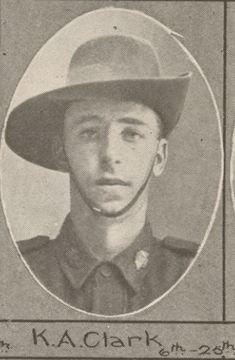Pte
King Richard Clark
Information about birth
|
Year of birth: 1893 |
|
Place of birth: Elsworth, Cambridgeshire, England, United Kingdom |
General information
|
Last known residence: Robert street, South Bundaberg, Queensland, Australia |
|
Profession: Labourer |
|
Religion: Church of England |
Army information
|
Country: Australia |
|
Force: Australian Imperial Force |
|
Rank: Private |
|
Service number: 2617A |
|
Enlistment date: 17/08/1915 |
|
Enlistment place: Brisbane, Queensland, Australia |
|
Units: — Australian Infantry, 47th Bn. (Last known unit) |
Information about death
|
Date of death: 12/10/1917 |
|
Place of death: Keerselaarhoek, Belgium |
|
Cause of death: Killed in action (K.I.A.) |
|
Age: 24 |
Cemetery
|
Tyne Cot Cemetery Plot: XXXIX Row: F Grave: 16 |
Distinctions and medals 3
|
1914-15 Star Medal |
|
British War Medal Medal |
|
Victory Medal Medal |
Points of interest 4
| #1 | Place of birth | ||
| #2 | Last known residence | ||
| #3 | Enlistment place | ||
| #4 | Place of death (approximate) |
My story
King Richard Clark was born in 1893, the son of Alfred King Clark and Eleanor Stone Lack. They lived in Elsworth, Cambridgeshire. At the age of 21, he emigrated to Australia. He arrived in Maryborough, Queensland on the ship 'Paparoa' on 15 November 1914. King Richard settled in South Bundaberg, Queensland where he worked as a labourer. On 17 August 1915, he volunteered for service in the Australian Army in Brisbane. It was not his first military experience. In England, he had already served three years in the Suffolk Regiment. After several months of training, he was sent to Tel-El-Kebir in Egypt, where he was assigned to the Australian Infantry, 47th Battalion.
In June 1916, the battalion disembarked at Marseille and was deployed during the Somme battles. Durint the Battle of Messines, the 47th was deployed between Messines and Ploegsteert and then took part in the Third Battle of Ypres. On 12 October 1917, the battalion had to protect the flank of the 3rd Australian Division during the attack on the village of Passchendaele. At 5.20 am the attack on Keiberg Spur was launched. The final objective was the Assyria - Vienna cottage line. Asyria was captured by the 48th Battalion, but the 47th Battalion ran into difficulties, was unable to advance further and had to retreat to its initial positions after heavy German counterattacks.
King Richard Clark, 24, was killed on 12 October 1917. His remains were exhumed after the war near the German cemetery ‘Keerselarehoek' and were interred at Tyne Cot Cemetery in 1920. He was identified by his name, which was scratched into his knife.
In June 1916, the battalion disembarked at Marseille and was deployed during the Somme battles. Durint the Battle of Messines, the 47th was deployed between Messines and Ploegsteert and then took part in the Third Battle of Ypres. On 12 October 1917, the battalion had to protect the flank of the 3rd Australian Division during the attack on the village of Passchendaele. At 5.20 am the attack on Keiberg Spur was launched. The final objective was the Assyria - Vienna cottage line. Asyria was captured by the 48th Battalion, but the 47th Battalion ran into difficulties, was unable to advance further and had to retreat to its initial positions after heavy German counterattacks.
King Richard Clark, 24, was killed on 12 October 1917. His remains were exhumed after the war near the German cemetery ‘Keerselarehoek' and were interred at Tyne Cot Cemetery in 1920. He was identified by his name, which was scratched into his knife.
Sources 6
|
47nd Battalion Australian Infantry (Australian War Memorial, Campbell (AWM), U56130. https://www.awm.gov.au/ Sources used |
|
Census Returns of England and Wales, 1911 (The National Archives, Kew (TNA), RG14). https://www.nationalarchives.gov.uk/ Sources used |
|
Deayton Craig , Battle Scarred: the 47th Battalion in the First World War (Newport Big Sky publishing Ltd, 2011).156-188. Sources used |
|
First Australian Imperial Force Personnel Dossiers, 1914-1920 (National Archives of Australia, Canberra (NAA), B2455). https://www.naa.gov.au/ Sources used |
|
McCarthy Chris., Passchendaele. The Day-by-Day Account (London, Unicorn Publishing Group, 2018), 128-130. Sources used |
|
Unit embarkation nominal rolls, 1914-18 War (Australian War Memorial, Campbell (AWM), AWM8). https://www.awm.gov.au/ Sources used |
More information 4
|
Commonwealth War Graves Commission Database https://www.cwgc.org/find-records/find-war-dead/casualty-details/462277/king-richard-clark/ |
|
Namenlijst (In Flanders Fields Museum) https://namenlijst.org/publicsearch/#/person/_id=295d83bc-54ad-4dd4-ae96-159c3f655518 |
|
The AIF Project (UNSW Canberra) https://aif.adfa.edu.au/showPerson?pid=53524 |
|
Lives of the First World War (Imperial War Museum) https://livesofthefirstworldwar.iwm.org.uk/lifestory/7319067 |
